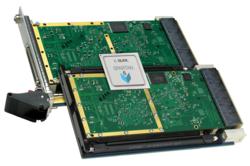Wixom, MI (PRWEB) June 24, 2011
Acromags new VPX-SLX series of 3U VPX FPGA boards provide powerful, but economical solutions for high-speed processing of algorithms in embedded computing applications. The VPX-SLX boards employ a configurable, logic-optimized Spartan-6 FPGA with 150k logic cells to meet demand for higher performance in cost-sensitive applications. These FPGA cards are designed to satisfy the performance requirements of many complex computing projects, at nearly half the cost, which previously required a flagship Xilinx Virtex or Altera Stratix class FPGA device. A high-throughput PCI Express interface, generous dual-ported memory for efficient data handling, and 64 I/O lines direct to the FPGA enable rapid data processing and great versatility. Ideal for defense, aerospace, or scientific research; typical applications involve signal intelligence, image processing, and hardware simulation. Pricing starts at $ 5200 for an air-cooled version and slightly higher in a conduction-cooled format.
The Spartan-6 FPGA offers outstanding performance at a very attractive price, states Joseph Primeau, Acromags sales and marketing director. When teamed with a PCI Express interface, the Spartan-6 FPGA is capable of meeting the performance requirements of many applications. Acromags VPX boards are optimized to rapidly transfer data between the FPGA and other system boards. A double fat pipe 4-lane PCIe interface ensures very fast data throughput. Dual-ported 1M x 64-bit SRAM enables high-speed DMA transfers to/from the CPU while simultaneously writing data to memory.
All VPX-SLX models use the XC6SLX150 Spartan-6 FPGA chip with 147,433 logic cells and 180 DSP48A1 slices. There are 64 I/O or 32 LVDS lines connected to the FPGA via the rear P2 connector. A series of AXM extension modules are available to provide additional front-end 16-bit A/D, differential RS-485, CMOS, or LVDS I/O processing channels through a mezzanine connector on the front of the card. FPGA code loads from the PCIe bus or from on-board flash memory. A JTAG and Xilinx ChipScope Pro interface are also supported to simplify development tasks.
For extended temperature range operation, models can be ordered with a frame for use in a conduction-cooled chassis. The standard model operates reliably over a 0 to 70

